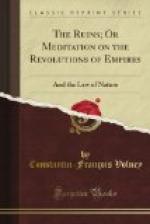“Now, according to calculations admitted by the Jews, they began to reckon near six thousand years since the supposed creation of the world.* This coincidence caused a fermentation in the public mind. Nothing was thought of but the approaching end. They consulted the hierophants and the mystical books, which differed as to the term; the great mediator, the final judge, was expected and desired, to put an end to so many calamities. This being was so much spoken of, that some person finally was said to have seen him; and a first rumor of this sort was sufficient to establish a general certainty. Popular report became an established fact: the imaginary being was realized; and all the circumstances of mythological tradition, being assembled around this phantom, produced a regular history, of which it was no longer permitted to doubt.
* According to the computation of the Seventy, the period elapsed consisted of about 5,600 years, and this computation was principally followed. It is well known how much, in the first ages of the church, this opinion of the end of the world agitated the minds of men. In the sequel, the general councils encouraged by finding that the general conflagration did not come, pronounced the expectation that prevailed heretical, and its believers were called Millenarians; a circumstance curious enough, since it is evident from the history of the gospels that Jesus Christ was a Millenarian, and of consequence a heretic.
“These mythological traditions recounted that, in the beginning, a woman and a man had by their fall introduced sin and misery into the world. (Consult plate of the Astrological Heaven of the Ancients.)
“By this was denoted the astronomical fact, that the celestial virgin and the herdsman (Bootes), by setting heliacally at the autumnal equinox, delivered the world to the wintry constellations, and seemed, on falling below the horizon, to introduce into the world the genius of evil, Ahrimanes, represented by the constellation of the Serpent.*
* “The Persians,” says Chardin, “call the constellation of the serpent Ophiucus, serpent of Eve: and this serpent Ophiucas or Ophioneus plays a similar part in the theology of the Phoenicians,” for Pherecydes, their disciple and the master of Pythagoras, said “that Ophioneus Serpentinus had been chief of the rebels against Jupiter.” See Mars. Ficin. Apol. Socrat. p. m. 797, col. 2. I shall add that ephah (with ain) signifies in Hebrew, serpent.
These traditions related that the woman had decoyed and seduced the man.*
* In a physical sense
to seduce, seducere, means only to
attract, to draw after
us.
“And in fact, the virgin, setting first, seems to draw the herdsman after her.




